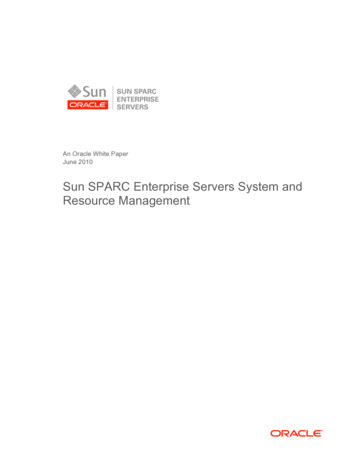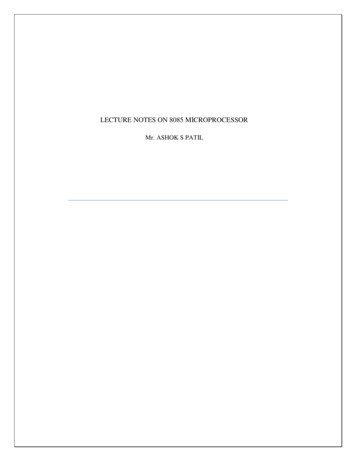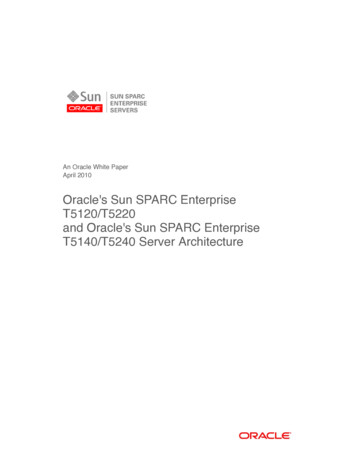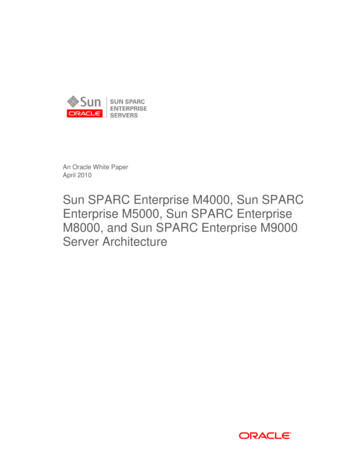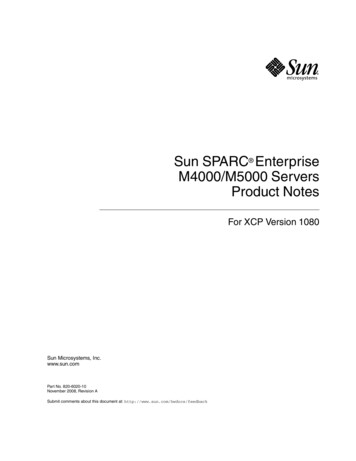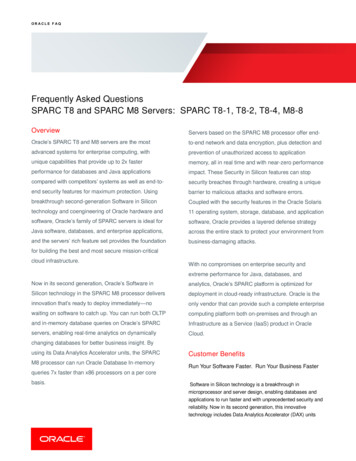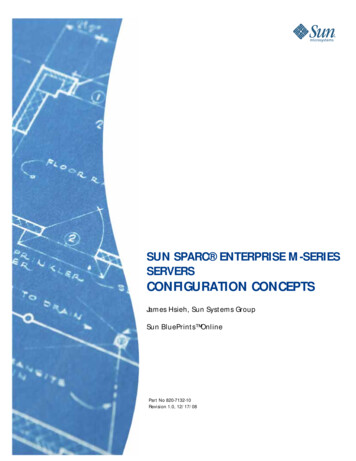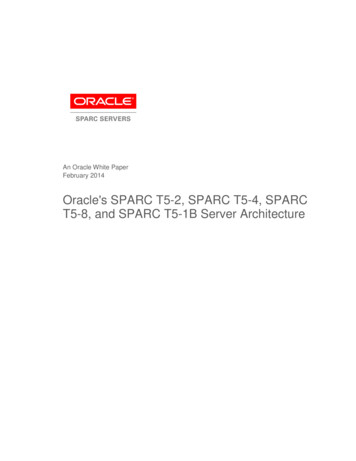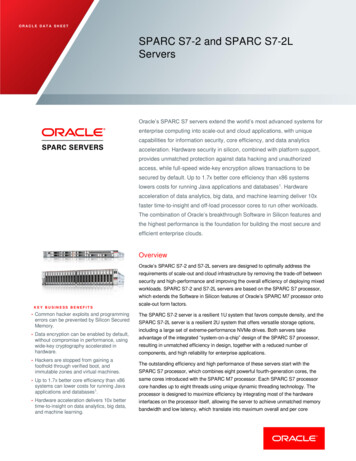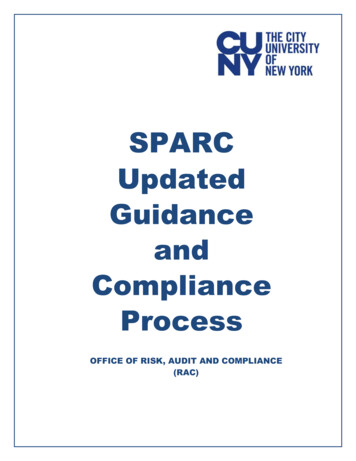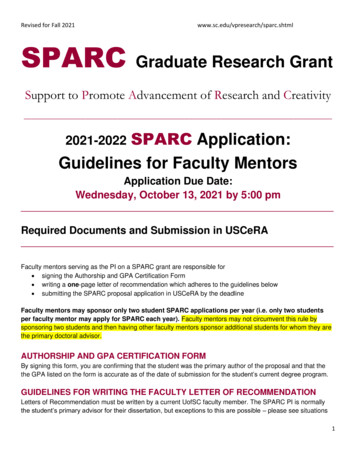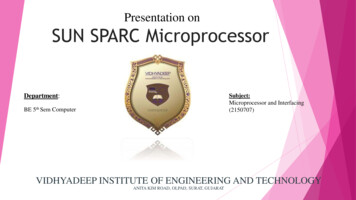
Transcription
Presentation onSUN SPARC MicroprocessorDepartment:Subject:Microprocessor and Interfacing(2150707)BE 5th Sem ComputerVIDHYADEEP INSTITUTE OF ENGINEERING AND TECHNOLOGYANITA KIM ROAD, OLPAD, SURAT, GUJARAT
CONTENT INTRODUCTION DESIGN GOALS HISTORY THE SPARCARCHITECTURE-Integer Unit (IU)-The Register Window-Floating Point Unit (FPU)-Coprocessor INSTRUCTIONS SPARCV9 FEATURES
Introduction SPARC stands for Scalable Processor Architecture. developed by Sun Microsystems in the 1980s. is based on the RISC structure designed at the University of California at Berkeley in early1980s. The SPARC architecture is a non-proprietary architecture that any person or company canlicense and use to develop microprocessors and other semiconductor devices based onpublished industry standards. In 1989, Sun Microsystems transferred ownership of the SPARC specifications to anindependent, non-profit organization, SPARC International, which administers and licensesthe technology and provides conformance testing and other services for its members.
Design Goals SPARC was designed as a target for optimizing compilers and easily pipelinedhardware implementations. SPARC implementations provide exceptionally highexecution rates(MIPS) and short time-to-market development schedules. Provide the scalability of the cost/performance ratio of successive implementationswith the current improvements in circuit technology. The "Scalable" in SPARC comes from the fact that the SPARC specification allowsimplementations to scale from processors required in embedded systems toprocessors used for servers.
Brief History 3 major revisions to the SPARC architecture- SPARC-V7, 32bit, 1986- SPARC-V8, 32bit, 1990- SPARC-V9, 64bit, 1993 Backward binary compatibility between them.In early 2006, Sun released an extendedUltraSPARC Architecture 2005.architecture specification,
The SPARC Architecture It is a Load and store architecture. Operations are always done overregisters. Uses “register window” concept thus offering a large number of registers. Uses delay slot to optimize branch instruction. Passes arguments using registers and the stack.
Fig. Architecture of sun sparc
The Integer Unit (IU) Contains the general purpose registers and controls the overall operationof the processor. may contain from 64 to 528 general-purpose 64-bit r registers. They arepartitioned into 8 global registers, 8 alternate global registers, plus acircular stack of from 3 to 32 sets of 16 registers each, known asregister windows. Executes the integer arithmetic instructions and computes memoryaddresses for loads and stores. Maintains the program counters and controls instruction execution forthe FPU.
The Register Window At any time, an instruction can access the 8 global registers and a 24-registerwindow A register window comprises a 16-register set- divided into 8 in and 8 localregisters- together with the 8 in registers of an adjacent register set, addressablefrom the current window as its out registers. When a procedure is called, the register window shifts by sixteen registers, hidingthe old input registers and old local registers and making the old output registersthe new input registers. Input registers : arguments are passed to a function Local registers : to store any local data. Output registers : When calling a function, the programmer puts his argument inthese registers.
The Register Window The current window into the r registers is given by the current windowpointer (CWP) register.
The Floating-point Unit (FPU) The FPU has 32 32-bit (single-precision) floating-point registers, 32 64-bit(double-precision) floating-point registers, and 16 128-bit (quad-precision)floating-point registers. Double-precision values occupy an even-odd pair of single-precision registers. Quad-precision values occupy an odd-even number pair of double precisionregisters. Floating-point load/store instructions are used to move data between the FPUand memory. The memory address is calculated by the IU. Floating-Point operate (FPop) instructions perform the floating-point arithmeticoperations and comparisons.
Coprocessor Unit (CU) The instruction set includes support for asingle, implementation-dependent coprocessor.The coprocessor has its own set of registers. Coprocessor load/store instructions are used tomove data between the coprocessor registersand memory. floating-point instructions mirrors coprocessorinstructions. Not implemented in SPARC V9.
InstructionsInstructions can fall into following basiccategories : Load/store Arithmetic/logical/shift Control transfer Read/write control register Floating-point/Coprocessor operate
SPARC v9 features 64-bit Data and Addresses as compared to 32-bit Data and Addresses ofSPARC V8. 32 double-precision floating-point registers, Software-settable branch prediction 64-bit integer multiply and divide instructions load/store floating-point quad word instructions Branches on register value (eliminating the need to compare) The V9 remains binary compatible with all previous SPARC architecture.
Vidhyadeep Institute of Engineering & TechnologyBranch:- ComputerYear:- 3rd (5th sem)Subject:- MPI
Topic:-8255A Microprocessor
Features of 8255A: The 8255A is a widely used, programmable, peripheral I/O device. It is compatible with all Intel and most other microprocessors. The 8255 can operate in 3 I/O modes:(1) Mode 0: Simple Input/Output(2) Mode 1: Input/Output With handshake(3) Mode 2: Bi-directional I/O data Transfer
Mode 0:In this mode, Port A and B is used as two 8-bit ports and Port C as two 4-bit ports. Each port can be programmed ineither input mode or output mode where outputs are latched and inputs are not latched. Ports do not have interruptcapability. Mode 1:In this mode, Port A and B is used as 8-bit I/O ports. They can be configured as either input or output ports. Eachport uses three lines from port C as handshake signals. Inputs and outputs are latched. Mode 2:In this mode, Port A can be configured as the bidirectional port and Port B either in Mode 0 or Mode 1. Port A usesfive signals from Port C as handshake signals for data transfer. The remaining three signals from Port C can be usedeither as simple I/O or as handshake for port B.
Block Diagram of 8255A:-
Data Bus Buffer:This three-state bi-directional 8-bit buffer is used to interface the 8255 to the system data bus. Data istransmitted or received by the buffer upon execution of input or output instructions by the CPU. Control Logic:The control logic block accepts control bus signals as well as inputs from the adress bus, and issues commandsto the individual group control blocks. Group A and Group B Controls:Each of the Group A and Group B control blocks receives control words from the CPU andIssues appropriate commands to the ports associated with it.
Port A:This has an 8-bit latched and buffered output and an 8-bit input latch. It can be programmed in threemodes: mode 0, mode 1, mode 2. Port B:This has an 8-bit data I/O latch/buffer and an 8-bit data input buffer. It can be programmed in mode 0and mode 1. Port C:This has one 8-bit unlatched input buffer and an 8-bit output latch/buffer. Port Ccan be separated into two parts and each can be used as control signals for ports A and B in the handshakmode.
Interfacing 8255 in i/o mapped i/oFig shows the interfacing of 8255 with 8085 in i/o mapped i/o technique.Here read and write signals are activated whensignal is high, indicating i/oBus cycle reset out signal from 8085 is connected to the RESET signal of the 8255.
Interfacing 8255 in memmory mapped i/oFig shows the interfacing of 8255 with 8085 in memory mapped i/o technique.Here read and write signals are activated when io/m signal is low, indicating memoryBus cycle. To get absolute address, all remaining address lines are used to decode theAddress for 8255. other signal connections are same as in i/o mapped i/o.
Thank You
VIDHYADEEP INSTITUTE OFENGINNERING AND TECHNOLOGYSubject:- Microprocessor And Interfacing[2150707]Topic:- 80286 MicroprocessorInternal Architecture80286 Interface
80286 Microprocessor Announced in 1982, the 5th of i86 Family 125k transistors, HMOS III technology Two mode of operations Real mode – operates as fast 8086/8088 Protected mode – enhances memory management, Multitasking and protection Improves both hardware and software Additional pipeline, demultiplexed address and data bus New enhanced instruction set (upward compat.) Pins are compatible with maximum mode of 8086
Internal Architecture Super class, base class, parent class: Terms to describethe parent in the relationship, which shares itsfunctionality. Subclass, derived class, child class: Terms to describethe child in the relationship, which accepts functionalityfrom its parent. Extend, inherit, derive: Become a subclass of anotherclass. 4 independent units (8086 has only two units) 24-bit Address bus Up to 7 times higher performance than 8086
Internal Architecture The 80286 consists of four separateprocessing units,They are : The Bus Unit (BU) The Address Unit(AU) The Execution Unit(EU) The Instruction Unit(IU)
The Bus Unit: The functions of the BU are :-To perform all memory and I/O read andwrites.-To prefetch the instruction bytes.-To control the transfer of data to and formprocessor extension devices like the 80287math co-processor.
The Address Unit: It consists of segment register, an offset address and aphysical address adder. The functions of the AU is to compute the physicaladdress that will be sent out to the memory or I/O bythe bus unit. We know the 80826 can operate in two differentmodes the real address mode and the protected virtualaddress mode.
The Execution Unit: The execution unit includes the ALU, registersand the CPU, the registers consists of thegeneral purpose register, index registerpointers, flag registers and the 16-bit machinestatus word register(MSW). The functions of the EU are-to sequentially execute the instructionsreceived from the instruction unit.-to direct the BU to access memory or I/Ooperands an needed.
The Instruction Unit: The instruction unit includes the 3 instructiondecoded queue and the instruction decoder. The function of the IU are:-to decode the prefetched instructions andhold them in an instruction queue, so thatthe EU can access them.-the IU decodes up to three(3) prefetchedinstructions. This helps the processor tospeed up, as pipelining of instruction is done.
Internal Architecture Bus Unit generates all data, address and I/Osignals. Prefetcher flushes the prefetched data, if IUfinds a branch instruction. Address Unit (AU) off-loads address generation,translation and checking from BU. Instruction Unit off-loads EU by performing theinstruction decoding. Execution Unit get the commands form IU,execute the instruction that maybe involveRegisters, ALU, AU such as ‘ADD AX, [SI].’
80286 Interface
Signal description of 80286 It has 4 part:1)Memory I/O interface signals.2)Interrupt interface signals.3)DMA interface signals.4)Coprocessor interface signals.
The Integer Unit (IU) Contains the general purpose registers and controls the overall operation of the processor. may contain from 64 to 528 general-purpose 64-bit r registers. They are partitioned into 8 global registers, 8 alternate global registers, plus a circular stack of from 3 to 32 sets of 16 registers each, known as
